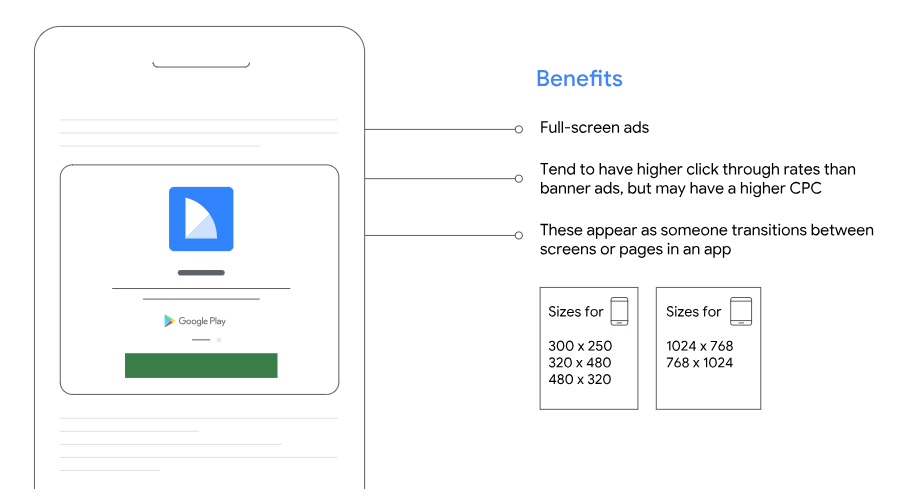What are Interstitial Ads and How do They Impact App Marketing?

When used correctly, interstitial ads are considered powerful tools in the app monetization arsenal.
This overview article will cover everything you need to know about interstitial ads, from their definition and benefits to best practices and Google’s guidelines.
Why Use Interstitial Ads?
Interstitial ads offer a full-screen ad experience that significantly boosts engagement and revenue.
These ads can be presented in various formats, including static images, videos, or interactive content. This versatility allows advertisers to create more dynamic and compelling ad experiences than other ad formats.
Higher visibility and creative flexibility often translate into higher click-through rates (CTR) than other ad formats. Simply put, users are more likely to engage with the ad content.
Another significant benefit of interstitial ads is their potential for higher revenue and lower ad spending.
Due to their full-screen nature, interstitial ads typically have higher effective cost per mille (CPM) impressions. Having high impressions is particularly helpful for app developers looking to maximize their ad revenue and when used in combination with Google app campaigns.
Additionally, many ad networks employ sophisticated targeting methods for interstitial ads that ensure the ads are relevant to the user’s interests and context. This relevance enhances the likelihood of user engagement and improves the overall performance of the ad campaign.

Benefits of Interstitial Ads; source: Google Ad Center
What Are the Best Practices for Interstitial Ads?
The best practices for interstitial ads are displaying the ads at natural transition points, capping ad frequency, ensuring ad relevance, focusing on creative quality, and pausing the app while the ad is displayed.
Here’s a short list of each best-ad practice.
Timing and Placement
Interstitial ads work best when displayed at natural transition points, such as after a user completes a game level or finishes a task.
This strategic placement minimizes disruption and makes the ad feel like a natural part of the app’s flow, thereby maintaining a positive user experience.
Ad Frequency
Showing interstitial ads too often can frustrate users and potentially result in app uninstalls. Marketers must balance monetization and user satisfaction by limiting the frequency of these ads.
Implementing frequency capping manages how often users see interstitial ads so they don’t become intrusive.
Ad Relevance
Ads should be tailored to the user’s interests and the app’s context. This relevance increases the likelihood of user engagement and improves the overall effectiveness of the ad campaign.
Utilize data and targeting options so the ads are relevant to the user’s current activity and preferences.
Ad Quality
High-quality visuals, engaging content, and interactive elements make interstitial ads more appealing and effective. Investing in creative design can lead to higher engagement rates and better ad performance.
Pause the Action
When displaying an interstitial ad, pause the app’s action. The pausing ensures that the user focuses entirely on the ad, which increases the likelihood of interaction.
For example, if the app plays audio, it should be paused when the interstitial ad is shown to avoid distractions.
Additionally, preloading interstitial ads can enhance the user experience by ensuring that the ad is ready to display at the optimal moment without any delays. Preloading also reduces the risk of disrupting the app’s flow and maintains a smooth user experience.
What Are the Types of Interstitial Ads?
The types of interstitial ads are text, image, video, and playable.
Each type of interstitial ad has strengths and can be tailored to specific advertising goals.
For example, text ads may be more suitable for direct response campaigns. In contrast, video ads can be powerful for brand awareness and storytelling. Playable ads, on the other hand, can be highly effective for driving app installs and engagement.
When choosing the type of interstitial ad to use, marketers should consider factors such as your target audience, advertising objectives, and the nature of your product or service.
Additionally, ads must comply with the guidelines and policies of the advertising platforms and app stores to provide a positive user experience. For instance, Google Play specifies how to work with interstitial ads.
Here’s a breakdown of each interstitial ad format:
Text Interstitial Ads
Text interstitial ads are the simplest form of interstitial advertising. They typically contain a headline, a brief description, and a call-to-action button.
While text-based ads may seem less engaging than their visual counterparts, they can be highly effective when crafted with compelling copy and a clear value proposition.
Image Interstitial Ads
These ads can range from simple product images to more elaborate graphics or illustrations.
Effective image interstitial ads often incorporate eye-catching designs, vibrant colors, and clear branding elements to leave a lasting impression on users.
Video Interstitial Ads
Video interstitial ads offer a more immersive and engaging experience for users. These ads can showcase product demonstrations, storytelling narratives, or short entertainment clips.
When executed well, video interstitial ads can effectively convey complex messages, evoke emotions, and drive user actions.
Playable Interstitial Ads
Playable interstitial ads take user engagement to the next level by allowing users to interact with the ad content directly.
These ads often feature mini-games, interactive demos, or simulations that provide users with hands-on experience of the advertised product or service.
Playable interstitial ads can be particularly effective for gaming apps, as they allow users to experience a snippet of the gameplay before downloading the app.
What Are the Challenges When Implementing Interstitial Ads?
The challenges of implementing interstitial ads are disrupting users’ experience, ad fatigue and difficulties with technical implementation.
We’ve compiled a deeper breakdown of each challenge below.
Disrupting User experience
One of the primary challenges of interstitial ads is their potential to disrupt the user experience. Suppose these ads are not strategically placed at natural transition points within the app. In that case, they can interrupt the flow of user activity.
The interruption leads to frustration and negative feedback.
For instance, displaying an interstitial ad in the middle of a game or while a user performs a critical task can be highly intrusive. This disruption can result in users abandoning the app altogether.
Ad Fatigue
When users are repeatedly exposed to the same interstitial ad, they may become annoyed and less likely to engage with the ad content.
This overexposure can diminish the effectiveness of the ads and lead to a decline in user satisfaction. To mitigate ad fatigue, marketers must implement frequency capping, which limits the number of times a user sees the same ad within a specific period.
This approach helps maintain a positive user experience while leveraging interstitial ads’ benefits.
Technical implementation Difficulties
Integrating these ads smoothly into an app requires careful planning and technical expertise. Developers must ensure that the ads load quickly and do not cause delays or crashes within the app.
Additionally, the timing of the ads must be carefully managed to avoid disrupting the user experience.
The right timing involves preloading the ads so they are ready to display at the optimal moment and pausing the app’s action when the ad is shown to ensure the user’s focus is on the ad.
Monitoring and Optimization
Continuously monitor the performance of your interstitial ads using analytics tools. Track metrics such as impressions, click-through rates (CTR), conversion rates, and user feedback. Use this data to optimize your ad placements, frequency, and content for better performance and user satisfaction.
Review and adjust your ad strategy regularly based on performance to maximize the effectiveness of your interstitial ads while maintaining a positive user experience.
What Are Interstitial Ad Guidelines?
Google introduced the Interstitial Ads Guidelines specifically to ensure a positive user experience and compliance with platform policies.
Here are the key guidelines to stick with.
Follow Platform Policies
Ensure that your interstitial ads comply with the ad policies of the platform you are using.
For example, Google AdMob and Facebook Audience Network have specific guidelines that must be followed. Google AdMob emphasizes placing interstitial ads at natural transition points within the app to avoid accidental clicks and provide a good user experience.
Similarly, Apple’s App Store guidelines require that ads do not interfere with the app’s core functionality or user experience.
Avoid Intrusiveness
Interstitial ads should not be displayed in a manner that excessively disrupts the user experience. According to Google AdMob, interstitial ads are best placed at natural transition points, such as between game levels or after completing a task, to minimize disruption.
Avoid showing interstitial ads immediately upon app launch or during critical user interactions, as this can lead to user frustration and negative feedback.
Respect User Privacy
Avoid collecting unnecessary user data and provide clear information about data collection practices. Users should have the option to opt out of data collection if they choose to do so.
Ensure your ads comply with privacy regulations like the General Data Protection Regulation (GDPR) and the California Consumer Privacy Act (CCPA).
Are There Penalties for Using Interstitial Ads?
Yes, there are penalties for misusing interstitial ads. If the ads are deemed too disruptive, Google has an intrusive interstitial penalty that can affect your app’s ranking.
The mentioned intrusive interstitial penalty is part of Google’s broader effort to improve the mobile user experience. This penalty specifically targets ads that interfere with users’ ability to access content seamlessly.
This penalty aims to ensure that users can easily access the information they are looking for without being obstructed by intrusive ads.
Impact of Interstitial Ads Penalties
The penalties for violating Google’s guidelines on interstitial ads may be a sudden drop in search rankings, reduced app visibility, and lower user engagement.
In severe cases, apps may be removed from the app store altogether. Markers and developers must clearly understand marketplace guidelines and implement interstitial ads to enhance the user experience rather than look for blackhat loopholes.
How to Avoid Interstitial Ad Penalties?
Marketers and developers should adhere to Google’s guidelines to avoid penalties associated with interstitial ads. Here are some must-know practices to follow.
Avoid Timing the Ad on App Launch
Avoid displaying interstitial ads immediately upon app launch. Instead, place them at natural transition points, such as between game levels or after completing a task. This approach minimizes disruption and enhances the user experience.
Don’t cover the whole screen
Ensure that interstitial ads do not cover the entire screen. Ads that occupy a smaller portion of the screen are less likely to be deemed intrusive. Additionally, avoid using ads that obscure the main content or require users to take action before accessing the content.
Provide Clear Exit Options
Provide clear and easily accessible exit options for interstitial ads. Users should be able to close the advertisement without difficulty and return to the app’s main content. Avoid using deceptive tactics, such as hiding the close button or making it difficult to find.
What Are Use Cases of Interstitial Ads?
There are many use cases for interstitial ads, such as In-App purchase promotion ads, content unlocking, app event promotion, app installations, survey participation or seasonal campaigns.
In-App Purchase Promotion
In mobile games, interstitial ads can promote in-app purchases. For instance, an interstitial ad can offer a special discount on in-game currency or items after a player completes a challenging level.
This type of ad leverages the user’s sense of achievement. It can effectively drive in-app purchases by presenting a timely and relevant offer.
Content Unlocking
Interstitial ads can unlock premium content in content-based apps, such as news or video streaming services.
For example, after a user finishes reading an article or watching a video, an interstitial ad can offer access to exclusive content in exchange for watching the ad. This approach monetizes the app and provides additional value to the user.
Event Promotion
Apps can use interstitial ads to promote special events or updates.
For example, a fitness app might display an interstitial ad to announce a new workout challenge or a seasonal promotion. These ads can drive user engagement and participation by highlighting time-sensitive events.
App Installation
Interstitial ads are also effective for cross-promoting other apps. For instance, a gaming app might display an interstitial ad for another game developed by the same company.
This type of ad can be particularly effective if the promoted app is relevant to the user’s interests and preferences.
Survey Participation
Some apps use interstitial ads to encourage users to participate in surveys or provide feedback.
For example, after completing a task or reaching a milestone, an interstitial ad can invite the user to take a short survey in exchange for a reward, such as in-app currency or a discount. This approach not only gathers valuable user insights but also enhances user engagement.
Seasonal Campaigns
During the holiday or special occasions, interstitial ads can promote seasonal offers or campaigns.
For example, a shopping app might display an interstitial ad featuring a holiday sale or a limited-time discount. These ads can create a sense of urgency and drive users to take advantage of the special offers.
Interstitial Ads vs Banners and Pop-ups
Understanding the strengths and limitations of each ad format helps app developers and marketers choose the most appropriate type for their monetization strategies.
Interstitial ads are ideal for high-impact campaigns that require full user attention and can be strategically placed to enhance engagement and revenue.
Banner ads, on the other hand, are better suited for maintaining a consistent ad presence with minimal disruption. Pop-up ads should be used judiciously to avoid negatively impacting the user experience.
Interstitial Ads Key Takeaways
Interstitial ads are a highly effective tool for app monetization. When used appropriately, they provide a full-screen experience that greatly enhances engagement and revenue.
App developers and marketers can seamlessly incorporate interstitial ads into their monetization plans when learning their advantages, best practices, and potential drawbacks.
Following platform guidelines and respecting user privacy is crucial to avoid penalties and ensure a positive user experience.
Each ad format, whether interstitial ads, banner ads, or pop-ups, has strengths and limitations. Strategically using these ad formats boosts user engagement, optimizes ad revenue, and maintains a positive user experience.
right in your inbox.


